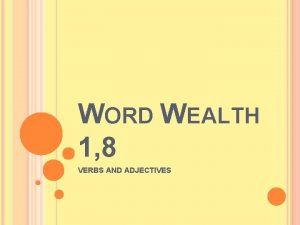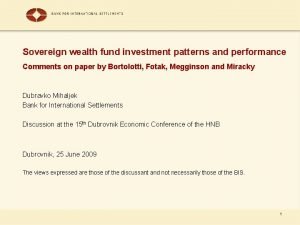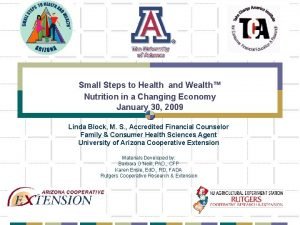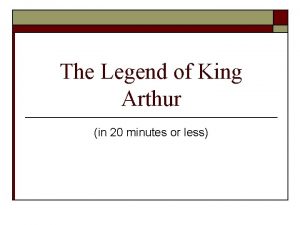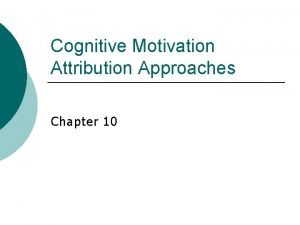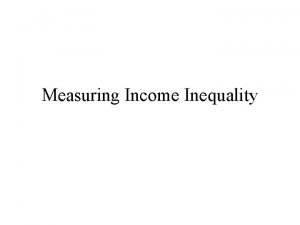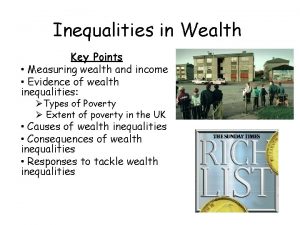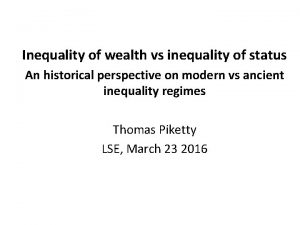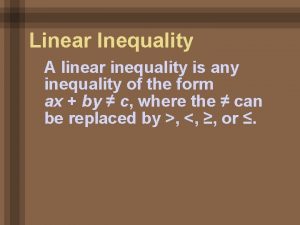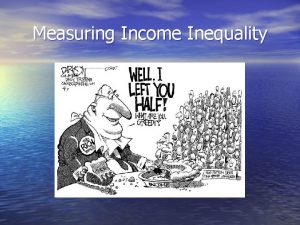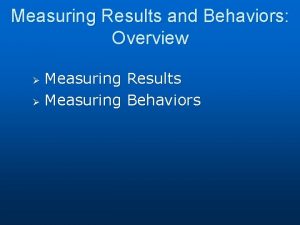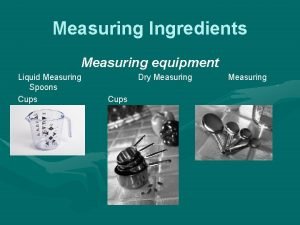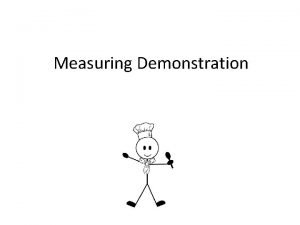Measuring Wealth and Wealth Inequality Arthur Kennickell Inequality




























































- Slides: 60

Measuring Wealth and Wealth Inequality Arthur Kennickell Inequality by the Numbers, III June 5 -9, 2017 Stone Center, CUNY 1

Gratitude to others • Many FRB and Eurosystem colleagues • Colleagues at SOI, especially Barry Johnson • Colleagues at NORC, especially Cathy Haggerty • Many statistics/economics colleagues—especially Fritz Scheuren • NORC field staff, who opened their minds to me • Survey respondents • Conference organizers, especially Janet Gornick • You, for listening 2

Outline • What is “wealth”? • How might we measure household wealth effectively? • Where are the growth points for wealth measurement? • What do we mean by “wealth inequality”? • (Largely SCF-centric: household surveys) 3

What is “wealth”? • Wealth is often confused with “income” • “Income” has its own definitional issues! • Obviously, interdependent concepts • Income can be seen as a return on some element of capital • Straightforward for interest on a bank account: Yt=rt*At • ”Imputed rent” on owner-occupied real estate • “Deferred income” more complicated • Pensions etc. • Capital gains that may not be realized in the current period • Return on “Human capital” (whatever that is!) is most important for most people over their lifetime • “Wealthy” people seem often to act to minimize their reportable income • Will return to relationship of income and wealth in the “way forward” 4

Joint distribution of household wealth and gross income, 2007 (“Dragon Plot”) 5

No universally agreed definition of wealth • There is no substitute for thinking about what you are doing • (But don’t be paralyzed by the fact: Learning by doing is inevitable) • Many conventional definitions of wealth • Should be driven as much as possible by analytical concerns • But also practical concerns/limitations • Most often, no “perfect” solution • “Jagger’s Theorem and Corollary” 6

Two examples • Analysis of the Survey of Consumer Finances (SCF) at FRB typically considers wealth as assets and liabilities that are, in principle, liquidatable or otherwise controllable by the owner • For considering the potential to move/influence markets • Fits reasonably with a macro perspective • One noted researcher does not treat vehicles as assets, but includes vehicle debt as a liability • Describes vehicles as nondurable consumption or a “necessity” • Implies far more negative net worth at the low end of the distribution that case treating vehicles as an asset • How different is a principal residence? 8

Hard-to-measure items may be important • Role of family or social networks in “insurance” • Vested rights to income, without direct asset ownership • Annuities, defined-benefit pensions, Social Security, income-only trust funds, etc. • Accrued value or account for future participation? • Valuation usually requires detailed knowledge of benefits and complicated assumptions about the future • For future DB pension (or SS) income for a current worker, typically need to know benefit structure, engagement to present (time and wage path), future engagement with plan, longevity, future inflation, appropriate discount rate, future solvency of the plan, … • Gross or net of future contributions? • Co-signed loans • Tax loss carryovers, share of national debt, etc. • Many “social goods” that may have different values for different people 9

Valuation in time • Some assets have a clear valuation at every time in highly liquid markets • E. g. , bank accounts, publicly traded stocks • Some asset types trade rarely—or (almost) never • Some assets have no directly observable market value, outside of the sale of a specific asset • Must assume some search interval • E. g. , closely held businesses, some types of bonds, artwork, unusual homes, etc. • Short of actual sale, a distribution of values may be most meaningful • Appraisals may generate different distributions, depending on the purpose • E. g. , willing buyer/willing seller vs. fire sale • Should the “value” of a fixed-rate mortgage be considered to change when interest rates change, as would be the case for a bond? • Depends on perspective 10

Other valuation issues • Some assets may have higher value in terms of use or productivity than would be reflected in a used asset market • A car, or a small business highly geared to specific human capital of the owner • Owner’s reservation price for a house may differ from market “comparable” due to idiosyncratic factors that have positive (or negative) value to the owner • Valuation sometimes more like “opinion” • Trade-off of risk and return over time • Affects future distribution of wealth • Limited access to some assets with high average returns: hedge funds, IPOs, private equity, etc. 11

Classes of wealth • Sometimes may care about wealth according to “purpose” (from perspective of the holder) • Consumption smoothing, durables/home, ”precaution, ” college education, retirement, “control, ” “investment” (in sense of future asset transformation or current strategy), bequests, … • In principle, wealth is fungible, so could argue accounting does not matter: but… • Monetary and psychic transactions costs of asset transformation can be substantial • Mental accounting • Different items of wealth may relate differently to behavior and expectations 12

Role of taxes • Many assets accumulate capital gains (or losses) that are not always required to be realized when they occur • E. g. , stocks, businesses, houses • Thus, net liquidation value of two assets with the same market value may differ to the extent they embed different levels of taxable capital gains • But relevant taxes are often difficult to determine • Some assets may never be liquidated, even after the lifetime of the owner • Typically, such differences are ignored 13

Whose wealth? • General tendency among income researchers to define “equivalized household income” • Divide income by a function of the number of household members and sometimes their characteristics • If nearly all income goes to current needs, perhaps easier to argue than for wealth • But wealth may serve variety of purposes spread over time • E. g. , retirement savings has relatively limited direct connection to children in a household • “Owner”/“controller”/”decision maker” for wealth may not be straightforward • Depends, in part, on intra-household arrangements • May be more than one such actor, based on ownership, specialization, etc. • Community property rules may override formal ownership • Broader “family wealth” 14

How might we measure household wealth effectively? • Various possible approaches: will focus on interviewer-mediated household surveys and return to broader possibilities later 1. Decompose desired measure of wealth into components we can expect people to understand have relevant conceptual meaning a) Order and describe to support analytic goals and data quality b) Include tools and other support for meaningful reporting 2. 3. 4. 5. Consider sample design deeply: Is oversampling the wealthy important? Address privacy concerns Acknowledge and support role of interviewers “Prepare for the worst” 15

What needs to be measured • Enumerate elements on which we want information to construct wealth • Typology depends on an analytic framework: most fundamental determinant of what can be done with the resulting data • Risk/liquidity • Transaction-related [credit cards, current accounts (checking or money market), stored-value cards] • Work related (pensions, businesses) • Mutual funds in multiple categories (directly held, money market accounts, managed accounts, 401(k) etc. plans, trusts) • In multinational context, conventional categories may differ in important ways • Associated characteristics • Insured vs. uninsured deposits, domestic vs. non-domestic stocks, investment characteristics for mutual funds, etc. • Ownership within household may be important for job-related items 16

Arrangement and detail • Terms and outward face of framework must be understandable to broad range of people • “Distribution of understanding” of language • Financial literacy issues • Wealthy people with complex portfolios have more possibilities for confusion • Sequencing/modulation matter: • Items that may appear relevant in multiple places: ask most obviously distinguishable one first • Psychological factors in sequencing • Affects on respondent’s “mood”/Establish different cognitive frameworks • Modulation of topics can defuse some problems • Level of detail: trade-offs • Comprehensiveness and clarity argue for very detailed decomposition and characterization of wealth: queue recognition for completeness and support clear definitions and distinctions • Risks of boring or alienating respondents (insincere/lazy answers and possible break-offs): argue for streamlining to some degree—how much? • SCF is designed as a broad wealth survey and collects very granular data along with variety of wealth characteristics (and other supporting variables) • 75 minutes median length, maximum several hours 17

Support for accurate reporting • Interviewers: #1 (will return to this) • Exhaustive testing and evaluation of all protocols • Design errors generally unrecoverable • Consider physical layout and capacity for maneuvering from interviewer’s perspective! • Guidance: put it where it is useful (Don Dillman) • Glossary • Instructions • Gentle pressure to use records • Provision for range responses • Inherent uncertainty of values • Sensitivity of exact responses • Uncertainty or unwillingness in mind of respondent • Live consistency checks/constraints • Great benefit of computer assisted personal interviewing (CAPI) 18

Sample design • Sample gives mathematical basis for scientific assessment of results • Need to decide how important is upper tail of the wealth distribution • US: Wealthiest 1% owns about 1/3 of total wealth (depends on wealth definition!) • Is analytical objective to understand: • • • Extreme wealth inequalities? Behavior/condition/welfare of the “bottom 99”? “Macroeconomic” possibilities? Specific economic characteristics/behaviors? Etc. ? • Without over-sampling strategy and means of coping with differential nonresponse with wealth, unreasonable to expect to have analytical objectives requiring accurate coverage of upper tail • But very expensive and very difficult to reach that population • Data often very difficult to collect/edit 19

SCF sample design • SCF must support both “macro” analysis and behavior of the general population • Dual-frame sample design • “Area-probability sample”: geographically based sample with selection probabilities proportional to population, using Census data and USPS postal address sequences • Robust method of covering the general population • Without some way of oversampling the very wealthy, would need an enormous sample to support (in principle) stable estimates of tail-dependent quantities, such as means • (Also, no effective way of addressing differential nonresponse • “List sample”: list of names/addresses selected from statistical records derived from individual tax returns • • • With cooperation of the Statistics of Income Division of the IRS Inefficient coverage of households other than high-income ones But allows high degree of over-sampling at the top of the distribution (Excludes “Forbes 400”) (Also supports effective adjustments for differential nonresponse) 20

List sample stratification • 21

Net worth share of wealthiest 1% 45. 0 Combined SCF area-probability and list samples 40. 0 35. 0 Percent share 30. 0 25. 0 20. 0 SCF area-probability sample only 15. 0 10. 0 5. 0 0. 0 1989 1992 1995 1998 2001 2004 2007 2010 2013

NW shares + confidence intervals 45. 0 40. 0 35. 0 Percent share 30. 0 25. 0 20. 0 15. 0 10. 0 5. 0 0. 0 -5. 0 99 -100 90 -99 50 -90 30 -50 10 -30 0 -10 Not allowed to show you confidence intervals for AP sample only, except for 2004! 1989 1992 1995 1998 2001 2004 2007 2010 2013

95% confidence intervals for top 1% share, 2004 (adjusted for difference in sample sizes) 50 45 40 35 30 25 20 15 10 5 0 AP only Combined AP and List 24

Household Finance and Consumption Survey • Wealth survey of the European Central Bank • Executed at the country level in the Euro Zone • Like SCF, specifically designed as a wealth survey • Ex ante harmonized to a high degree across countries • Some important institutional differences across countries • Not possible to standardize approach to sampling • Some countries (e. g. , Spain and France) have access to tax-based data for oversampling • Most other countries have weaker (or no) instruments for oversampling • Key concern is developing a way to make robust comparisons of taildependent estimates 25

Privacy concerns • Why would anyone share such personal information with a stranger? • • • Voluntary participation Fear of strangers No computer system is 100% safe Fears of identity theft or exploitation for commercial purposes Suspected political motivation, etc. • “How do I know this is legitimate? ” • Directly address hesitations • “Authority letters”/Federal Register/Community engagement/etc. • Role of CIPSEA in U. S. : applies to “data creators” • But no legal constraints on users! • Disclosure reduction techniques for published data • Including data simulation 26

Role of interviewers • Interviewers are the (largely) unsung heroes of social science research • Require technical ability to navigate survey, personal skills to engage respondents, flexibility, persistence and resilience • Professional work for a nonprofessional wage! • Legacy of false “golden age” of women “who didn’t need to work” • Most productive 20% complete half the interviews • Differences in interview quality • Focus on training critical, but not sufficient • Agent-principal problem • Interviewers’ work observed only indirectly • Role of supportive feedback 27

Quality vs. Completion Rates, Across Interviewers, 2004 28

“Prepare for the worst” • Plan for success, but prepare for possible failure: • Misreporting • Misunderstanding, deliberately incorrect answer, question error, etc. • Missing data • Unconditional missing and conditional missing • Unit nonresponse • Variety of reasons • Data fabrication • (Other types of error) 29

Editing the raw data • Driven by comments, debriefing notes and computer-driven review • Correct errors/misclassifications/omissions • Most often, editing review reveals • Respondent did not understand/accept • The question • Confidentiality protections • Purpose of the interview • • • The interviewer did not understand or lacked motivation The interviewer did not follow instructions Question wording was ambiguous Underlying concept shifted Situation was too confusing to cope with effectively 30

Editing is a recognition of failure • Communication failure! • Generate feedback to educate/motivate interviewers • New strategies to engage respondents • Devise improved strategies for next time • Editing does not create truth • Some “in-liers” difficult to observe • Always some chance edits are wrong • Expensive/labor intensive: possible to achieve most benefits at much lower cost, via model-based selection • Editing may have uncomfortably large effects on outcomes 31

Number of edits, SCF AP sample • Quality improvement program in place in 2010 32

Percent quantile difference plot: 2010 NW: (Edited value-unedited value)/ABS(edited data) 33

Quantile difference plot: 2010 NW: Edited value-unedited value Wealth negative in this range 34

Role of imputation for missing data • Why not use only cases with complete data? • Possibilities for selection bias, as well as reduced estimation efficiency • Most SCF cases have at least some missing variable • Greater wealth usually implies greater asset diversity, and thus more opportunities for missing (or garbled) data • Data creator often has more information than a general user • Imputation does not create truth • Imputation, at its best, creates a transparent representation of the estimated distribution of the missing data, conditional on observed data • Single imputation • Represents that distribution by one value • Multiple imputation • Uses multiple draws from the conditional distribution, both to better reflect the uncertainty and to increase efficiency 35

Selected reports of dollar amounts, 1995 CCard. Bal House Mortgage Rent Business Wages 100 90 80 70 60 50 40 30 20 10 0 Have Unknown Number Any. Range DK Oth. miss. 36

Data fabrication • Always a risk that a field interviewer, who works alone, may make up the all data or part of the data • Profoundly undermines usefulness/credibility of data • May also affect respondents adversely • Sometimes collusion with respondents • Costly methods of detection • Validating interviews • Review of case records for suspicious patterns • Where prevalent enough to serve as basis for study, the survey is highly likely to be worthless for its intended purpose • Healthy culture is best defense • Monitoring is secondary defense that serves mainly to support credibility 37

Case management • Beyond initial “eager respondents” contact/persuasion strategy becomes critical • Ultimately, strategies are formulated at the level of individual cases • For wealthy respondents, locating them and navigating their “gatekeepers” is a major issue • Conflicting ethics: every voice should be heard, but no one should be harassed • “Incentives” can be helpful in motivating some people or giving a sense of “value” to the work • But may be seen by human subjects committee as manipulative bribery when applied to poor people • May create suspicion among other people: “Why are you paying me? ” • Definitely not a panacea • “Nonresponse” is, in part, a judgement about when/whether to stop 38

Cumulative distribution completed interviews; by number of weeks in the field; 2007 39

Cumulative distribution of attempts: 2007 AP sample 40

Cumulative distribution of attempts: 2007 High-stratum list sample 41

Hazard Rates* of case completion: AP and high-stratum LS 10. 0 9. 0 Complete, LS 6+7 8. 0 Percent 7. 0 Complete, AP 6. 0 5. 0 4. 0 3. 0 2. 0 1. 0 0. 0 1 3 5 7 9 11 13 * % of “unresolved” cases completed 15 17 19 21 23 25 27 Weeks given sample in the field 29 31 33 35 37 39+

Response Rates, by Sample Type, 2007 70 60 Percent 50 Far higher response than would be the case without targeted effort 40 30 20 10 0 All AP All LS Str 1 Str 2 Str 3 Str 4 Sample group Str 5 Str 6 Str 7

Weighing adjustments • Sampling weights = 1/Probability(Selection) • Applies to entire sample: respondent and nonrespondents • Weighting calibration/adjustment is chance to “compensate” for differences in nonresponse for various subpopulations • Although conventionally done, weighting does not create truth • E. g. , “aligning” with demographic categories effective in reducing bias only if nonresponse (or under-coverage) correlated with demographics • Nonresponse bias is relative to an analytic objective • Research shows that nonresponse is strongly correlated with wealth proxies, and independently with financial income • SCF sample design supports wealth-related adjustment • AP and list samples combined respecting the strengths of each approach 44

Accounting for uncertainty • Uncertainty is a statistical property—most often speak of “variance” • Variance estimation too often treated as “nicety” • Most often, pro forma “± x%” • No science without meaningful ability to characterize the strength of estimates • Very common and shockingly frequent disregard of this point • In principle, should include ALL sources of uncertainty • Sampling, nonresponse, data handling/processing error, other nonsampling error— conceptual/specification error • In practice, usually limited to sampling and nonresponse error • SCF combines replicate weight approach to sampling error and unit nonresponse with multiple imputation to unit nonresponse error 45

Where are the growth points for wealth measurement? • Continuous improvement—structuring work for learning—should be a baseline • Unfortunately, research on survey adjustments for problems attracts more intellectual attention than research to avoid problems • “Autopilot” all too common: entropy • Also need to look beyond current practice • • Serious SCF-type wealth panel data of relatively short duration Exploit administrative data (Not necessarily independent) Others… 46

Joint distribution of NW, 2007 and 2009 47

Real change in ∆NW, 2007 -2009 48

Exploiting administrative data Mainly, estate tax and personal income tax data • Estate data: Mallet [1908], Lampman [1962], Scheuren [1962] … • Death as a mechanism for sampling from the living population • Issues of valuation, appropriate death probabilities, person vs. household • Saez and Zucman [2016] • Estimate wealth from personal income tax data • Tax unit vs. individuals/households • Fixed rates of return • Single time period • Some important similarities with SCF sampling • Statisticians have long argued for pooling multiple data sources • Information and technology now more within grasp 49

Hybrid of survey and modeling • Surveys face escalating costs and pressures from nonresponse • May not be sustainable in current form • Match survey data with concurrent, past and future tax-based (and other) data—largely, income data • • • Evaluate survey responses Model measured wealth conditional on administrative data Project both survey data and independent estimates More efficient use of available information BUT privacy and legal issues need to be addressed 50

What do we mean by “wealth inequality”? • 51

Cumulative distributions: 1988 and 2006 income/1989 and 2007 net worth 52

Lorenz curves: 1988, 2003 and 2006 total gross family income and 1989 2004 and 2007 net worth 53

Gini coefficient for net worth with confidence interval 0. 83 0. 82 0. 81 0. 8 0. 79 0. 78 0. 77 0. 76 0. 75 0. 74 1989 1992 1995 1998 2001 2004 2007 54

Percent share Wealth shares (repeat) 45. 0 40. 0 35. 0 30. 0 25. 0 20. 0 15. 0 10. 0 5. 0 0. 0 -5. 0 99 -100 30 -50 1989 1992 1995 1998 90 -99 10 -30 2001 50 -90 0 -10 2004 2007 2010 2013 55

Households with zero or negative NW Negative Zero <=0 14 12 10 8 6 4 2 0 1989 1992 1995 1998 2001 2004 2007 2010 2013 56

Wealth of Forbes 400 as % SCF wealth (could also show as share of median from a “normal” survey) 3. 5 3 2. 5 2 1. 5 1 0. 5 0 1989 1992 1995 1998 2001 2004 2007 2010 2013 57

Relative quantile difference plot: %Δ real wealth 58

Relative quantile difference plot: %Δ gross income 59

60

Thanks for your attention! Questions/comments? Arthur. Kennickell@gmail. com 61
 1-6 solving compound and absolute value inequalities
1-6 solving compound and absolute value inequalities Myths and legends of king arthur
Myths and legends of king arthur Apush 1820 to 1860
Apush 1820 to 1860 Ladbroke v todd
Ladbroke v todd Guinevere arthurian legend
Guinevere arthurian legend The crucible introduction
The crucible introduction John arthur world hunger and moral obligation
John arthur world hunger and moral obligation Symbols for happiness
Symbols for happiness Wealth and wisdom institute
Wealth and wisdom institute St john chrysostom on wealth and poverty pdf
St john chrysostom on wealth and poverty pdf Wealth adjectives
Wealth adjectives Sovereign wealth fund investment patterns and performance
Sovereign wealth fund investment patterns and performance Wealth nutrition
Wealth nutrition Barbara o'neill diet plan
Barbara o'neill diet plan Quirk and kachru debate
Quirk and kachru debate Dgp week 11 answers 9th grade
Dgp week 11 answers 9th grade Mc arthur
Mc arthur Anestezjolog studia
Anestezjolog studia Arthur (boo) radley
Arthur (boo) radley Scout's character traits
Scout's character traits Mc arthur
Mc arthur Fashion magazine history
Fashion magazine history King arthur childhood
King arthur childhood Fatsly
Fatsly Essential questions for the crucible
Essential questions for the crucible Ditte lysgaard vind
Ditte lysgaard vind What does steady the buffs mean in an inspector calls
What does steady the buffs mean in an inspector calls The catcher in the rye chapter 14
The catcher in the rye chapter 14 Character traits of arthur in button button
Character traits of arthur in button button Michael arthur ucl
Michael arthur ucl William arthur philip louis
William arthur philip louis Port arthur housing authority
Port arthur housing authority Arthur holmes contribution to plate tectonics
Arthur holmes contribution to plate tectonics Legenden om kung arthur
Legenden om kung arthur David crystal
David crystal Clement hongler
Clement hongler Dr arthur chou
Dr arthur chou Arthur davison children's hospital
Arthur davison children's hospital Edna woolman chase
Edna woolman chase Eric arthur blair biography
Eric arthur blair biography Eric arthur
Eric arthur Facts about arthur miller
Facts about arthur miller Exposé arthur rimbaud
Exposé arthur rimbaud Frangibolt wikipedia
Frangibolt wikipedia Exonormative stabilization
Exonormative stabilization Arthur miller 1949
Arthur miller 1949 Arthur dvali
Arthur dvali Internal attribution
Internal attribution Charlotte bronte father
Charlotte bronte father Gerald croft character traits
Gerald croft character traits Arthur davidson legal
Arthur davidson legal Mc arthur
Mc arthur Amulya babu
Amulya babu Young arthur 2002
Young arthur 2002 Sicard invention
Sicard invention Arthur krigsman
Arthur krigsman Arthur okun
Arthur okun Stage directions an inspector calls
Stage directions an inspector calls King arthur family tree
King arthur family tree A hanging george orwell
A hanging george orwell George orwell biographical information
George orwell biographical information










